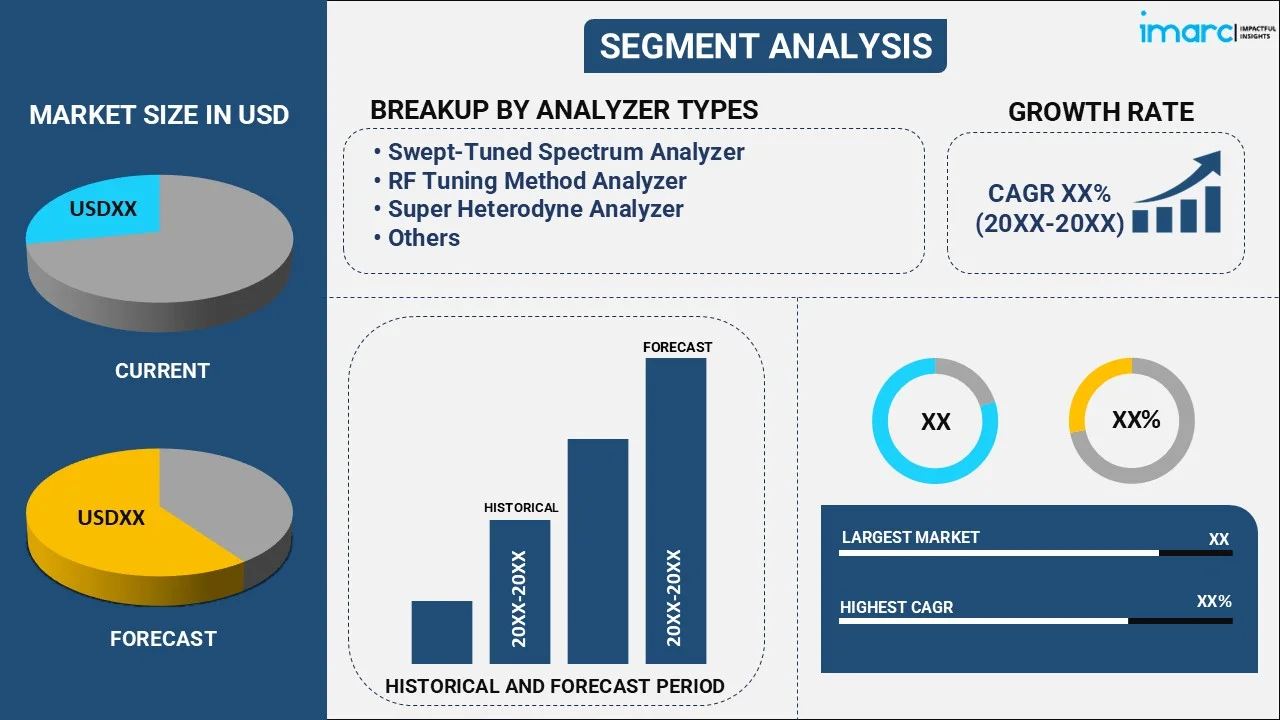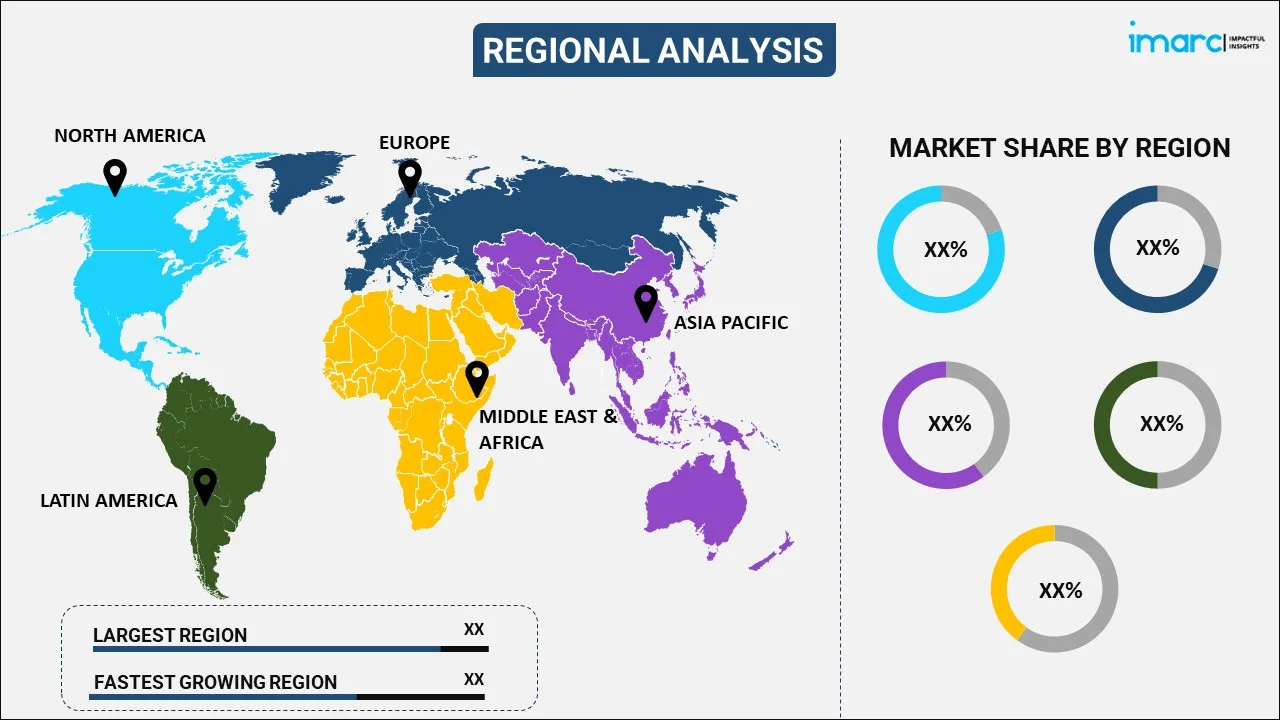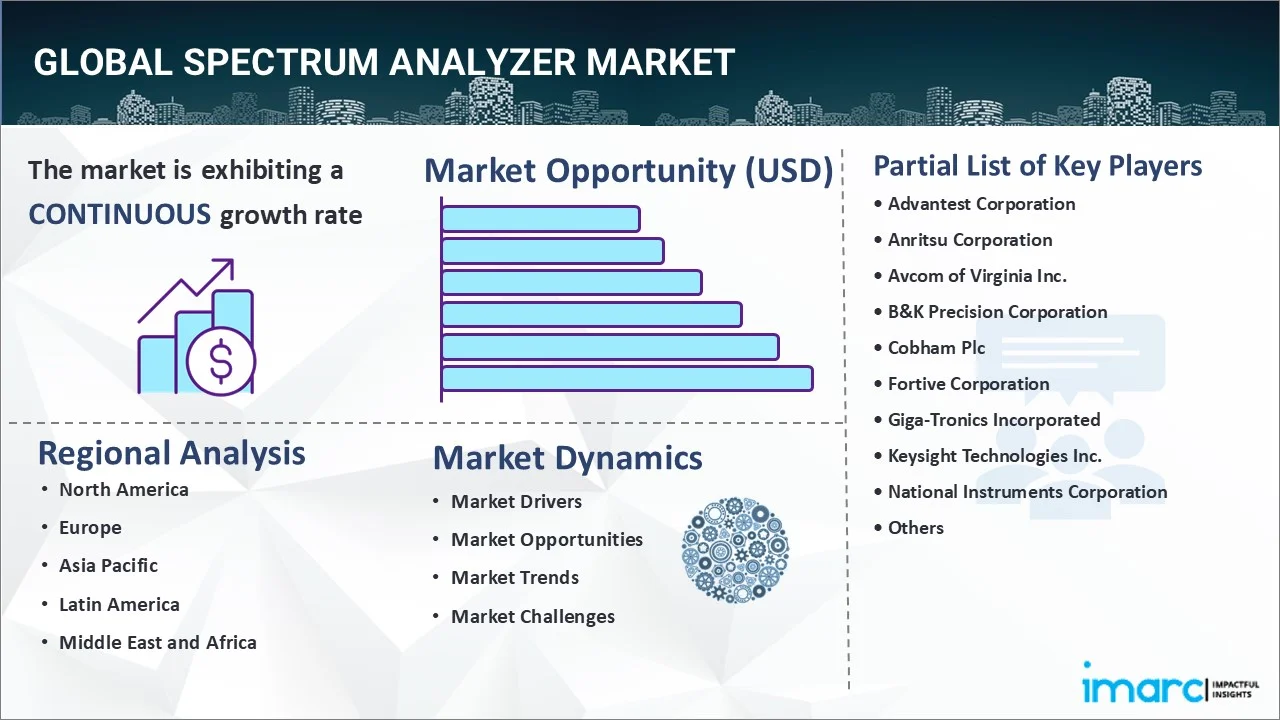
Spectrum Analyzer Market Report by Analyzer Type (Swept-Tuned Spectrum Analyzer, RF Tuning Method Analyzer, Super Heterodyne Analyzer, Vector Signal Spectrum Analyzer, Real-Time Spectrum Analyzer, Fast Fourier Transform Analyzer, Parallel Filter Analyzer, Audio Spectrum Analyzer, and Others), Offering (Hardware, Software), Frequency Range (<6 GHz, 6GHz-18 GHz, >18 GHz), Design Type (Handheld Spectrum Analyzer, Portable Spectrum Analyzer, Benchtop Spectrum Analyzer, and Others), Technology Type (Wired, Wireless), End-Use Industry (Automotive, IT & Telecommunication, Aerospace, Defense, Medical, Electronics, Educational, Energy, and Others), and Region 2025-2033
Global Spectrum Analyzer Market:
The global spectrum analyzer market size reached USD 1.7 Billion in 2024. Looking forward, IMARC Group expects the market to reach USD 3.1 Billion by 2033, exhibiting a growth rate (CAGR) of 6.63% during 2025-2033. The market is experiencing steady growth because of the heightened focus on strengthening the military and defense sector, increasing expansion of the telecommunication industry and availability of 5G connection, and rising demand for high frequency electronic devices.
|
Report Attribute
|
Key Statistics
|
|---|---|
|
Base Year
|
2024
|
|
Forecast Years
|
2025-2033
|
|
Historical Years
|
2019-2024
|
|
Market Size in 2024
|
USD 1.7 Billion |
|
Market Forecast in 2033
|
USD 3.1 Billion |
| Market Growth Rate 2025-2033 | 6.63% |
Spectrum Analyzer Market Analysis:
- Major Market Drivers: The proliferation of electronic devices, including smartphones, tablets, and smart home devices, drives demand for spectrum analyzers in testing processes. Moreover, the continuous push towards Industry 4.0 and automated manufacturing processes requires precise measurement and monitoring of communication systems, driving the adoption of spectrum analyzers in industrial settings.
- Key Market Trends: Advances in research across fields, such as physics, telecommunications, and materials science, drive the demand for sophisticated spectrum analyzers. In addition to this, ongoing technological innovations in spectrum analyzer technology, such as improvements in real-time analysis, signal processing, and measurement accuracy, are driving the adoption of these instruments. Enhanced features and capabilities, like higher frequency ranges and better resolution, contribute to market growth.
- Competitive Landscape: Some of the prominent spectrum analyzer market companies include Advantest Corporation, Anritsu Corporation, Avcom of Virginia Inc., B&K Precision Corporation, Cobham Plc, Fortive Corporation, Giga-Tronics Incorporated, Keysight Technologies Inc., National Instruments Corporation, Rohde & Schwarz GmbH & Co. Kg., Teledyne Lecroy Inc., and Yokogawa Electric Corporation, among many others.
- Geographical Trends: According to the spectrum analyzer market dynamics, North America exhibits a clear dominance in the market. The ongoing rollout of 5G networks across the region significantly drives the demand for spectrum analyzers. These devices are crucial for testing and optimizing 5G infrastructure, including frequency management, signal integrity, and network performance.
- Challenges and Opportunities: High costs of advanced spectrum analyzers and high competition among key players are hampering the market's growth. However, the rise of advanced automotive technologies, including autonomous vehicles and connected car systems, creates new opportunities for spectrum analyzers to test and validate automotive electronics.
Spectrum Analyzer Market Trends:
Expansion of 5G Networks
The expansion of 5G networks is driving the market's growth. For instance, India's nationwide 5G availability expanded throughout 2023. 5G availability increased from nearly 28% in Q1 to 52% in Q4 2023, a 23.9 percentage point gain in just a year. The widespread rollout of 5G networks requires spectrum analyzers for testing and optimizing new infrastructure. These devices help in managing frequency allocation, ensuring signal integrity, and improving overall network performance. These factors are expected to propel the spectrum analyzer market in the coming years.
Rising Demand for IoT Devices
The expansion of the Internet of Things (IoT) sector is significantly driving the growth in the spectrum analyzer market. For instance, according to IMARC, the global Internet of Things (IoT) market size reached US$ 887.6 Billion in 2023. Looking forward, IMARC Group expects the market to reach US$ 3,174.2 Billion by 2032, exhibiting a growth rate (CAGR) of 15.21% during 2024-2032. IoT devices operate across a wide range of frequency bands, including sub-GHz frequencies for long-range communications and higher frequencies for short-range, high-speed data transfer. This diverse frequency range necessitates the use of spectrum analyzers to manage and analyze the spectrum effectively. These factors are further positively influencing the spectrum analyzer market forecast.
Technological Advancements
Ongoing advancements in spectrum analyzer technology, such as improvements in real-time analysis, enhanced resolution, and broader frequency ranges, are driving the market growth. Innovations in digital signal processing and software-defined radio are also contributing to this trend. For instance, in June 2021, Signal Hound, a manufacturer of RF test and measurement equipment, introduced the BB60D, a six GHz real-time spectrum analyzer with significant performance improvements over the market favorite BB60C, thereby boosting the spectrum analyzer market share.
Global Spectrum Analyzer Industry Segmentation:
IMARC Group provides an analysis of the key trends in each segment of the market, along with forecasts at the global, regional, and country levels for 2025-2033. Our report has categorized the market based on analyzer type, offering, frequency range, design type, technology type, and end use industry.
Breakup by Analyzer Type:

- Swept-Tuned Spectrum Analyzer
- RF Tuning Method Analyzer
- Super Heterodyne Analyzer
- Vector Signal Spectrum Analyzer
- Real-Time Spectrum Analyzer
- Fast Fourier Transform Analyzer
- Parallel Filter Analyzer
- Audio Spectrum Analyzer
- Others
Swept-tuned spectrum analyzer accounts for the majority of the market share
The report has provided a detailed breakup and analysis of the market based on the analyzer type. This includes swept-tuned spectrum analyzer, RF tuning method analyzer, super heterodyne analyzer, vector signal spectrum analyzer, real-time spectrum analyzer, fast fourier transform analyzer, parallel filter analyzer, audio spectrum analyzer, and others. According to the report, swept-tuned spectrum analyzer represented the largest segment.
According to the spectrum analyzer market outlook, a swept-tuned spectrum analyzer is a type of electronic measurement tool that determines the amplitude of signals across different frequencies within an input signal. It can measure a signal's amplitude at different frequencies one after the other, resulting in a spectrum display that shows the relationship between signal amplitude and frequency. Depending on the model and design, swept-tuned spectrum analyzers can cover a broad range of frequencies, usually from a few kHz to tens or even hundreds of GHz. With a wide frequency range, swept-tuned analyzers can be used for high-frequency microwave signals as well as audio and broadcast frequencies.
Breakup by Offering:
- Hardware
- Software
Hardware accounts for the majority of the market share
A detailed breakup and analysis of the market based on the offering have also been provided in the report. This includes hardware and software. According to the report, hardware represented the largest segment.
Hardware consists of various essential tools that create the integral design and functionality of spectrum analyzers. Key hardware components include the input attenuator, the local oscillator (LO), and the mixer, where the input signal is combined with the LO frequency to produce an intermediate frequency (IF).
Breakup by Frequency Range:
- <6 GHz
- 6 GHz-18 GHz
- >18 GHz
The report has provided a detailed breakup and analysis of the market based on the frequency range. This includes <6 GHz, 6 GHz-18 GHz, >18 GHz.
According to the spectrum analyzer market overview, spectrum analyzers with a frequency range of <6 GHz are commonly used in various applications that involve lower frequency bands, including most traditional communication systems, basic research, and industrial applications. Moreover, spectrum analyzers that cover the 6 GHz to 18 GHz frequency range are crucial for advanced applications that require higher frequency analysis, particularly in sectors, such as aerospace, defense, and satellite communications. Besides this, spectrum analyzers designed to operate above 18 GHz are indispensable in high-frequency applications, notably in fields such as telecommunications and research. This frequency range includes millimeter-wave bands that are crucial for advanced radar systems used in military and aviation applications, as well as for emerging automotive radar technologies in self-driving and assisted-driving vehicles.
Breakup by Design Type:
- Handheld Spectrum Analyzer
- Portable Spectrum Analyzer
- Benchtop Spectrum Analyzer
- Others
Benchtop spectrum analyzer exhibits a clear dominance in the market
A detailed breakup and analysis of the market based on the design type have also been provided in the report. This includes handheld spectrum analyzer, portable spectrum analyzer, benchtop spectrum analyzer, and others. According to the spectrum analyzer market report, benchtop spectrum analyzer accounted for the largest market share.
Benchtop spectrum analyzers are widely employed for stationary usage in laboratories, manufacturing plants, and other settings where detailed and comprehensive spectral analysis is needed. They are characterized by their robust design, wide feature sets, and superior functionalities compared to their handheld counterparts. Benchtop spectrum analyzers are essential tools for radio frequency (RF) and microwave engineers, researchers, and technicians due to their high precision, reliability, and advanced functionality.
Breakup by Technology Type:
- Wired
- Wireless
Wired exhibits a clear dominance in the market
The report has provided a detailed breakup and analysis of the market based on the technology type. This includes wired and wireless. According to the report, wired accounted for the largest market share.
Wired spectrum analyzers are standardized ones that require physical connections for power and data communication. They are primarily employed in laboratory settings, manufacturing applications, and field operations, where detailed and precise spectral analysis is needed.
Breakup by End-Use Industry:
- Automotive
- IT & Telecommunication
- Aerospace
- Defense
- Medical
- Electronics
- Educational
- Energy
- Others
IT and telecommunication are the predominant market segment
A detailed breakup and analysis of the market based on the end use industry have also been provided in the report. This includes automotive, IT and telecommunication, aerospace, defense, medical, electronics, educational, energy, and others. According to the report, IT and telecommunication accounted for the largest market share.
Spectrum analyzers are important for the maintenance, optimization, and troubleshooting of communication systems in the IT and telecom industries. These gadgets are necessary to guarantee that networks run smoothly, adhere to legal requirements, and offer the level of service that users need and that technology standards demand. Through analysis of the frequency spectrum utilized for communications, spectrum analyzers assist in the optimization of wireless networks by determining the ideal configurations for signal strength and clarity.
Breakup by Region:

- North America
- United States
- Canada
- Asia Pacific
- China
- Japan
- India
- South Korea
- Australia
- Indonesia
- Others
- Europe
- Germany
- France
- United Kingdom
- Italy
- Spain
- Russia
- Others
- Latin America
- Brazil
- Mexico
- Others
- Middle East and Africa
North America leads the market, accounting for the largest spectrum analyzer market share
The report has also provided a comprehensive analysis of all the major regional markets, which include North America (the United States and Canada); Asia Pacific (China, Japan, India, South Korea, Australia, Indonesia, and others); Europe (Germany, France, the United Kingdom, Italy, Spain, and others); Latin America (Brazil, Mexico, and others), the Middle East; and Africa. According to the report, North America represents the largest regional market for spectrum analyzers.
The North America spectrum analyzer market is driven by the increasing investments in the expansion of telecommunication infrastructure. The increasing deployment of 5G technology, which needs extensive testing and monitoring to ensure proper performance, is driving the need for spectrum analyzers. Moreover, the rising focus on strengthening the military and defense activities in the region to strengthen border security is propelling the growth of the market. Spectrum analyzers are essential in the aspect of developing, testing, and retaining military communication systems. According to the information provided by SIPRI, the United States spent $916 billion on national defense in 2023.
Competitive Landscape:
The market research report has provided a comprehensive analysis of the competitive landscape covering market structure, market share by key players, market player positioning, top winning strategies, competitive dashboard, and company evaluation quadrant, among others. Detailed profiles of all major companies have also been provided. This includes business overview, product offerings, business strategies, SWOT analysis, financials, and major news and events. Some of the major market players in the spectrum analyzer industry include:
- Advantest Corporation
- Anritsu Corporation
- Avcom of Virginia Inc.
- B&K Precision Corporation
- Cobham Plc
- Fortive Corporation
- Giga-Tronics Incorporated
- Keysight Technologies Inc.
- National Instruments Corporation
- Rohde & Schwarz GmbH & Co. Kg.
- Teledyne Lecroy Inc.
- Yokogawa Electric Corporation
(Please note that this is only a partial list of the key players, and the complete list is provided in the report.)
Spectrum Analyzer Market Recent Developments:
- September 2024: Aaronia AG announced to demonstrate real-time spectrum analyzers using waveguide technology at the European Microwave Week (EuMW) in Paris.
- May 2024: Anritsu Corporation, a test and measurement solutions provider, launched: the Site Master MS2085A Cable and Antenna Analyzer and the MS2089A with Integrated Spectrum Analyzer.
- November 2023: Signal Hound, a maker of high-performance and accessible test equipment, launched its new spectrum analyzer, the SP145.
Spectrum Analyzer Market Report Scope:
| Report Features | Details |
|---|---|
| Base Year of the Analysis | 2024 |
| Historical Period | 2019-2024 |
| Forecast Period | 2025-2033 |
| Units | Billion USD |
| Scope of the Report | Exploration of Historical Trends and Market Outlook, Industry Catalysts and Challenges, Segment-Wise Historical and Predictive Market Assessment:
|
| Analyzer Types Covered | Swept-Tuned Spectrum Analyzer, RF Tuning Method Analyzer, Super Heterodyne Analyzer, Vector Signal Spectrum Analyzer, Real-Time Spectrum Analyzer, Fast Fourier Transform Analyzer, Parallel Filter Analyzer, Audio Spectrum Analyzer, Others |
| Offerings Covered | Hardware, Software |
| Frequency Ranges Covered | <6 GHz, 6 GHz-18 GHz, >18 GHz |
| Design Types Covered | Handheld Spectrum Analyzer, Portable Spectrum Analyzer, Benchtop Spectrum Analyzer, Others |
| Technology Types Covered | Wired, Wireless |
| End-Use Industries Covered | Automotive, IT & Telecommunication, Aerospace, Defense, Medical, Electronics, Educational, Energy, Others |
| Regions Covered | Asia Pacific, Europe, North America, Latin America, Middle East and Africa |
| Countries Covered | United States, Canada, Germany, France, United Kingdom, Italy, Spain, Russia, China, Japan, India, South Korea, Australia, Indonesia, Brazil, Mexico |
| Companies Covered | Advantest Corporation, Anritsu Corporation, Avcom of Virginia Inc., B&K Precision Corporation, Cobham Plc, Fortive Corporation, Giga-Tronics Incorporated, Keysight Technologies Inc., National Instruments Corporation, Rohde & Schwarz GmbH & Co. Kg., Teledyne Lecroy Inc., Yokogawa Electric Corporation, etc. |
| Customization Scope | 10% Free Customization |
| Post-Sale Analyst Support | 10-12 Weeks |
| Delivery Format | PDF and Excel through Email (We can also provide the editable version of the report in PPT/Word format on special request) |
Key Questions Answered in This Report:
- How has the global spectrum analyzer market performed so far, and how will it perform in the coming years?
- What are the drivers, restraints, and opportunities in the global spectrum analyzer market?
- What is the impact of each driver, restraint, and opportunity on the global spectrum analyzer market?
- What are the key regional markets?
- Which countries represent the most attractive spectrum analyzer market?
- What is the breakup of the market based on the analyzer type?
- Which is the most attractive analyzer type in the spectrum analyzer market?
- What is the breakup of the market based on the offering?
- Which is the most attractive offering in the spectrum analyzer market?
- What is the breakup of the market based on the frequency range?
- Which is the most attractive frequency range in the spectrum analyzer market?
- What is the breakup of the market based on the design type?
- Which is the most attractive design type in the spectrum analyzer market?
- What is the breakup of the market based on the technology type?
- Which is the most attractive technology type in the spectrum analyzer market?
- What is the breakup of the market based on the end use industry?
- Which is the most attractive end use industry in the spectrum analyzer market?
- What is the competitive structure of the market?
- Who are the key players/companies in the global spectrum analyzer market?
Key Benefits for Stakeholders:
- IMARC's report offers a comprehensive quantitative analysis of various market segments, historical and current market trends, market forecasts, and dynamics of the spectrum analyzer market from 2019-2033.
- The research study provides the latest information on the market drivers, challenges, and opportunities in the global spectrum analyzer market.
- The study maps the leading, as well as the fastest-growing, regional markets. It further enables stakeholders to identify the key country-level markets within each region.
- Porter's five forces analysis assists stakeholders in assessing the impact of new entrants, competitive rivalry, supplier power, buyer power, and the threat of substitution. It helps stakeholders to analyze the level of competition within the spectrum analyzer industry and its attractiveness.
- The competitive landscape allows stakeholders to understand their competitive environment and provides insight into the current positions of key players in the market.
Need more help?
- Speak to our experienced analysts for insights on the current market scenarios.
- Include additional segments and countries to customize the report as per your requirement.
- Gain an unparalleled competitive advantage in your domain by understanding how to utilize the report and positively impacting your operations and revenue.
- For further assistance, please connect with our analysts.

 Inquire Before Buying
Inquire Before Buying
 Speak to an Analyst
Speak to an Analyst
 Request Brochure
Request Brochure
 Request Customization
Request Customization




.webp)




.webp)












